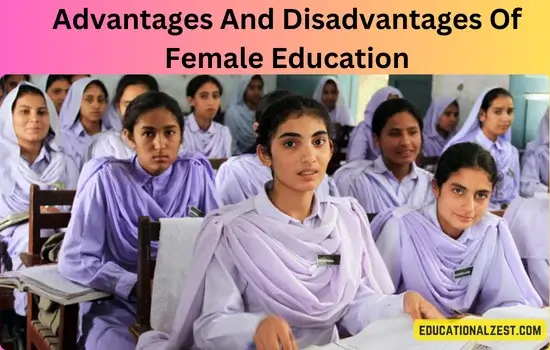When a society needs to progress properly, then the use of Female education is of utmost importance. It is true that there have been significant progresses made by the females in different parts of the world in different fields, still there are a lot to be done, a great many inequalities to be overcome. This is where the aspect of female education comes to a great importance. For the women to rise up and face all the challenges around the world, this is the most imperative requirement. In fact a great many discourses carry on regarding this matter. We will here try to show you the both sides, the advantages and disadvantages of starting female education, even though, it is beyond argument that the disadvantages are archaic in nature.

Advantages of Female Education
Empowerment:
Women need education, skills, and confidence to make life, career, and health decisions. Women who are educated are more likely to advocate for their rights, challenge gender norms, and make family and community decisions. Women may develop critical thinking and life skills in school. By learning about their rights, reproductive health, financial literacy, and other topics, women may make empowered and healthy choices. Women need communication, problem-solving, and leadership skills for personal and professional success. Education provides them.
Economic Opportunities:
Education empowers women economically. Women with good education may establish enterprises, earn more, and reduce poverty and increase economic growth. Many countries require women’s labor force participation for sustainable development and poverty reduction. Educated women can navigate the market, gain skills, and find more opportunities. Education permits women to work in STEM fields despite gender conventions. By overcoming misconceptions and institutional barriers, educated women may boost creativity, productivity, and competitiveness. Women entrepreneurs and business leaders benefit from education.
Gender Equality:
Education fights gender stereotypes and promotes equality. A gender-equal education helps women attain political, workforce, and decision-making parity. Equal education for women may challenge gender conventions and promote social fairness. Education empowers girls and young women to overcome gender stereotypes and accomplish their objectives, encouraging gender equality. Education equips women with the skills, knowledge, and confidence to challenge stereotypes and lead in male-dominated fields. More girls and women in STEM fields promote gender equality and encourage future women. Women’s participation in decision-making at all levels requires education.
Social Development:
Women’s education advances society. They are more likely to volunteer, lobby, and establish communities to fight poverty, illiteracy, and gender-based violence. Educated women mobilize resources and aid to empower underprivileged communities and promote social justice. Educated women support social development via community and grassroots initiatives. Women with education may identify local needs, coordinate resources, and implement sustainable social solutions. Educated women build communities from the ground up, improving healthcare, the environment, and economic empowerment.
Political Participation:
The education of women promotes society. They volunteer, advocate, and form groups to combat poverty, illiteracy, and gender-based violence. Educated women organize help and resources to uplift poor communities and promote social justice. Educational women promote social change via community and grassroots efforts. Women with education may recognize local needs, manage resources, and create durable social solutions. Educational women develop communities from scratch, improving healthcare, the environment, and economic empowerment.
Disadvantages of Female Education
Resistance from Traditional Societal Norms:
Traditional cultures may see female education as harmful to authority. Girls may drop out of school due to family, social, and religious pressure. Domestic and caregiving duties have hampered women’s education in patriarchal societies. These strong gender norms sometimes suggest that females’ education is futile due to their domestic duty. Families may prioritize male children’s education, sustaining gender privilege and academic discrepancies. Tradition holds that girls’ education may disrupt social hierarchies and power structures. Educational women question gender stereotypes and exhibit their individuality and agency, which others may find disruptive or subversive.
Early Marriage and Childbearing:
Female education may promote early marriage and children. Family may see learning as meaningless or unpleasant in communities where girls are expected to marry young. Girls may drop out of school to marry and have children, perpetuating poverty and inequality. Cultural and social standards that prioritize traditional family structures above females’ personal development and ambitions might lead to early marriage and childbirth. Many communities see women’s education as secondary to their roles as brides and mothers, with marriage as the ultimate goal and status marker.
Limited Access to Resources:
Resource constraints hamper females’ education despite gender equality efforts. Economic hardship may drive families to choose male education over female education, sustaining gender inequalities. Many families prefer to support the education of male breadwinners while females are expected to remain housewives due to budgetary constraints. Poor infrastructure hinders female education in rural or impoverished areas. Lack of schools, especially secondary schools, forces girls to travel far, raising dropout and safety risks. Women have trouble getting to school due to poor transportation.
Security Concerns and Safety Risks:
Beginning female education in some settings may heighten security and safety risks. In conflict, political instability, and social upheaval, armed groups or terrorists may target schools. Violence may prohibit families from sending their daughters to school, perpetuating illiteracy and marginalization. Fast security degradation in conflict-affected regions leads to school attacks and intimidation. Armed groups may assault females’ schools to restrict education and rights. These attacks endanger children and teachers and make families afraid to send their daughters to school.
Gender-based Discrimination and Harassment:
Despite laws and campaigns, gender-based school discrimination and harassment occur worldwide. Teachers, students, and administrators may mistreat girls and young women, lowering their confidence and school spirit. For female students, sexual harassment, bullying, and intimidation may create hostile learning environments that cause psychological distress and academic disengagement. School cultures and regulations may reinforce gender stereotypes and uneven treatment.
Conclusion
When it comes to female education, a lot of advantages and hurdles are underway. This is where more works are needed, to improve the system and raise more awareness in the minds of the people. Also taking help of the government and different social working teams is essential here.